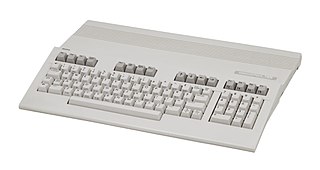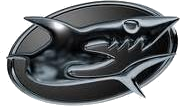
The Doctor V64 is a development and backup device made by Bung Enterprises Ltd that is used in conjunction with the Nintendo 64. The Doctor V64 also had the ability to play Video CDs, audio CDs and had an option for applying stereo 3D effects to the audio.

The Game Boy Color is a handheld game console, manufactured by Nintendo, which was released in Japan on October 21, 1998 and to international markets that November. It is the successor to the Game Boy and is part of the Game Boy family.

The Commodore 128, also known as the C128, C-128, C= 128, is the last 8-bit home computer that was commercially released by Commodore Business Machines (CBM). Introduced in January 1985 at the CES in Las Vegas, it appeared three years after its predecessor, the bestselling Commodore 64.

The Family Computer Disk System, commonly shortened to the Famicom Disk System or just Disk System, is a peripheral for Nintendo's Family Computer home video game console, released only in Japan on February 21, 1986. It uses proprietary floppy disks called "Disk Cards" for cheaper data storage and it adds a new high-fidelity sound channel for supporting Disk System games.

The 64DD is a magnetic floppy disk drive peripheral for the Nintendo 64 game console developed by Nintendo. It was announced in 1995, prior to the Nintendo 64's 1996 launch, and after numerous delays was released in Japan on December 13, 1999. The "64" references both the Nintendo 64 console and the 64MB storage capacity of the disks, and "DD" is short for "disk drive" or "dynamic drive".
The megabit is a multiple of the unit bit for digital information. The prefix mega (symbol M) is defined in the International System of Units (SI) as a multiplier of 106 (1 million), and therefore

GameShark is the brand name of a line of video game cheat cartridges and other products for a variety of console video game systems and Windows-based computers. Currently, the brand name is owned by Mad Catz, which marketed GameShark products for the Sony PlayStation, Xbox, and Nintendo game consoles. Players load cheat codes from GameShark discs or cartridges onto the console's internal or external memory, so that when the game is loaded, the selected cheats can be applied.
Homebrew, when applied to video games, refers to games produced by hobbyists for proprietary video game consoles which are not intended to be user-programmable. Official documentation is often only available to licensed developers, and these systems may use storage formats that make distribution difficult. Many consoles have hardware restrictions to prevent unauthorized development. A non-professional developer for a system intended to be user-programmable, like the Commodore 64, is simply called a hobbyist.

The Rainbow 100 was a microcomputer introduced by Digital Equipment Corporation (DEC) in 1982. This desktop unit had a monitor similar to the VT220 in a dual-CPU box with both 4 MHz Zilog Z80 and 4.81 MHz Intel 8088 CPUs. The Rainbow 100 was a triple-use machine: VT100 mode, 8-bit CP/M mode, and CP/M-86 or MS-DOS mode using the 8088.

The Nintendo Power is a Japan-only peripheral produced by Nintendo for the Super Famicom and the Game Boy. The service allowed owners to download Super Famicom or Game Boy games onto a special flash memory cartridge for a lower price than that of the full cartridge.

This article is about the various external peripherals of the Commodore 64 home computer. Due to the backwards compatibility of the Commodore 128, most peripherals will work on that system, as well. There's some compatibility with the VIC-20 and PET too.

The CD64 is a game backup device made by UFO/Success Company for the Nintendo 64 that allows users to run ROM files off a CD-ROM attached to the system. Similar to the Doctor V64 and the Z64 units for the N64, it is most commonly used for playing backups of Nintendo 64 games. Since it has a built-in communications port that is accessible from the N64 program, it can also be used as a rather versatile development/debug device.

A game cartridge, usually referred to in context simply as a cartridge, cart, or card, is a replaceable part designed to be connected to a consumer electronics device such as a home computer, video game console or, to a lesser extent, electronic musical instruments. A special type of cartridge named ROM cartridge is a memory card containing ROM. ROM cartridges can be used to load and run software such as video games or other application programs.
Nintendo 64 accessories include first party Nintendo hardware—and third party hardware, licensed and unlicensed. Nintendo's first party accessories are mainly transformative system expansions: the 64DD Internet multimedia platform, with a floppy drive, video capture and editor, game building setup, web browser, and online service; the controller plus its own expansions for storage and rumble feedback; and the RAM-boosting Expansion Pak for big improvements in graphics and gameplay. Third party accessories include the essential game developer tools built by SGI and SN Systems on Nintendo's behalf, an unlicensed SharkWire online service, and unlicensed cheaper counterparts to first party items. The Nintendo 64 video game console had a market lifespan from 1996 to 2002.

A game backup device, formerly usually called a copier and more recently a flash cartridge, is a device for backing up ROM information from a video game cartridge to a computer file called a ROM image and playing them back on the real hardware. Recently flash cartridges, especially on the Game Boy Advance and Nintendo DS platforms, only support the latter function; they cannot be used for backing up ROM data. Game backup devices also make it possible to develop homebrew software on video game systems. Game backup devices differ from modchips in that modchips are used in conjunction with systems that use generally available media such as CDs and DVDs, whereas game backup devices are used with systems that use cartridges.

RAM pack, RAMpack, RAM expansion cartridge, RAM expansion unit (REU), memory expansion pak and memory module are some of the most common names given to various self-contained units or cartridges that expand a computer, games console or other device's own internal RAM in a user-friendly manner.
This article describes the processor, memory, and other components of the 1996 Nintendo 64 home video game console.

Nintendo 64 Game Pak is the brand name of the consumer ROM cartridge product that stores game data for the Nintendo 64, released in 1996. As with Nintendo's previous consoles, the Game Pak's design tradeoffs were intended to achieve maximal system speed and minimal base console cost—with lesser storage space and a higher unit cost per game. Integrating a CD-ROM drive, with its expensive and slow moving parts, would have drastically increased the console's base price by 50% and reduced its performance.

The Super Nintendo Entertainment System Game Pak is the system's default ROM cartridge medium. It is called Game Pak in most Western regions, and Cassette in Japan and parts of Latin America. While the Super NES can address 128 Megabits, only 117.75 Megabits are actually available for cartridge use. A fairly normal mapping can easily address up to 95 Megabit of ROM data with 8 Megabits of battery-backed RAM. However, most available memory access controllers only support mappings of up to 32 Megabits. The largest games released contain 48 Megabits of ROM data, while the smallest games contain 2 Megabits.
















